Conveyors - Capacities
Calculate conveyor capacities.

Conveyor capacity is determined by the belt speed, width and the angle of the belt - and can be expressed as
Q = ρ A v (1)
where
Q = conveyor capacity (kg/s, lb/s)
ρ = density of transported material (kg/m3, lb/ft3)
A = cross-sectional area of the bulk solid on the belt (m2, ft2)
v = conveyor belt velocity (m/s, ft/s)
The cross-sectional area of the bulk solid on the belt can be calculated as
A = U b2 (2)
where
U = non-dimensional cross-sectional area shape factor
b = contact perimeter between bulk material and belt (m, ft)
Non-dimensional cross-sectional area shape factors for various troughing belts are available from manufacturers' handbooks.
Typical Conveyor Capacity
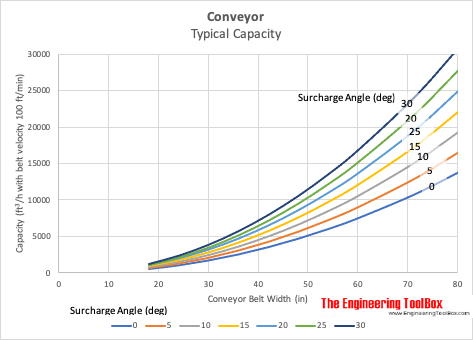
- 1 in = 25.4 mm
- 1 ft3/h = 0.028 m3/h
- 1 ft/min = 5.08×10-3 m/s
The product cross sectional area is defined by the idler trough shape and the product pile on top of the idler trough the trapezoid shape. This section on top of the trapezoid can be described with a circle and the angle this circle makes with the belt is the surcharge angle.
Typical Conveyor Cross Sectional Area
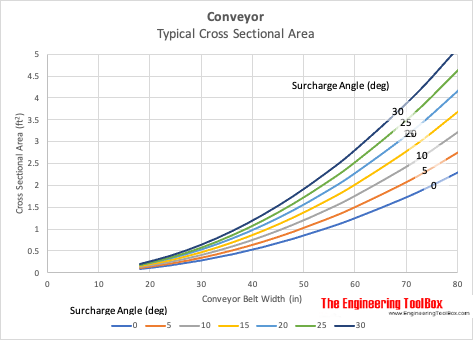
- 1 ft2 = 0.0929 m2
Typical Surcharge Angles
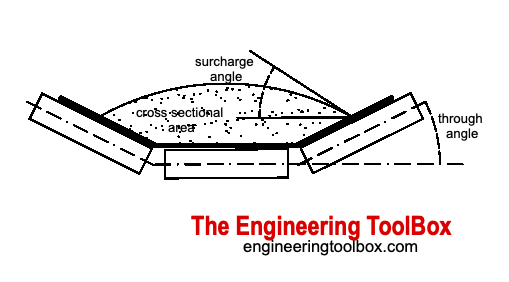
| Material | Surcharge Angle (degrees) |
|---|---|
| Alum | 25 |
| Alumina | 10 |
| Aluminium sulphate | 20 |
| Ammonium chloride | 10 |
| Ammonium nitrate | 25 |
| Asbestos shred | 30 |
| Ashes, coal, dry | 25 |
| Ashes, coal, wet | 25 |
| Ashes, fly | 30 |
| Ashes, gas producer, wet | 30 |
| Asphalt | 30 |
| Bagasse | 30 |
| Bark, wood | 30 |
| Barley | 10 |
| Bauxite, ground, dry | 20 |
| Bauxite, mine run | 20 |
| Beans | 5 |
| Beet, pulp, dry | 30 |
| Beets, whole | 20 |
| Borax | 20 |
| Brewers grain wet | 30 |
| Brick | 30 |
| Calcium carbide | 20 |
| Carbon black, pelletised | 5 |
| Cashew nuts | 30 |
| Cement, portland | 25 |
| Cement clinker | 25 |
| Chalk, lumpy | 10 |
| Chalk, 100 mesh and under | 25 |
| Charcoal | 25 |
| Chrome ore | 10 |
| Cinders, blast furnace | 10 |
| Cinder, coal | 20 |
| Clay, dry, fines | 20 |
| Clay, dry, lumpy | 20 |
| Coal, anthracite, 3mm and under | 20 |
| Coal, anthracite, sized | 10 |
| Coal, bituminous, mined 50 mesh and under | 30 |
| Coal, bituminous, mined and sized | 20 |
| Coal, lignite | 25 |
| Cocoa beans | 10 |
| Coke, breeze, 6mm and under | 20 |
| Concrete wet | 24 |
| Copper ore | 20 |
| Copper sulphate | 20 |
| Corn, ear | 25 |
| Cornmeal | 20 |
| Cottonseed cake | 20 |
| Dolomite | 18 |
| Earth, as dug, dry | 20 |
| Earth, wet, with clay | 30 |
| Feldspar | 25 |
| Flaxseed | 10 |
| Flour, wheat | 30 |
| Fluorspar | 30 |
| Foundry sand, old sand cores etc. | 25 |
| Fullers earth, dry | 10 |
| Glass batch | 10 |
| Granite, broken, 75mm lumps | 10 |
| Graphite, flake | 10 |
| Gravel, pebbles | 10 |
| Gypsum, dust, not-aerated | 20 |
| Gypsum, dust, aerated | 30 |
| Gypsum, 75mm lumps | 10 |
| Illmenite ore | 10 |
| Iron ore, coarse crushed | 20 |
| Iron ore, crushed fine | 20 |
| Lead ores | 10 |
| Lead oxide, light | 25 |
| Lignite, air dried | 10 |
| Lime, ground, 3mm and under | 30 |
| Lime, hydrated | 25 |
| Lime, pebble | 10 |
| Limestone, agricultural 3mm and under | 10 |
| Limestone, crushed | 25 |
| Linseed cake | 20 |
| Linseed meal | 20 |
| Magnesium chloride | 30 |
| Magnesium sulphate | 10 |
| Manganese ore | 25 |
| Manganese sulphate | 10 |
| Marble, crushed 12mm and under | 10 |
| Mica, ground | 20 |
| Mica, pulverized | 10 |
| Mica, flakes | 5 |
| Molybdenite, powdered | 20 |
| Mortar, wet | 24 |
| Nickel-cobalt | 10 |
| Oats | 10 |
| Peanuts in shells | 10 |
| Peas, dried | 5 |
| Phosphate, triple super ground fertilizer | 20 |
| Phosphate rock, pulverized | 25 |
| Potash ore | 10 |
| Pyrites, pellets | 10 |
| Quartz | 10 |
| Rice | 5 |
| Rock, crushed | 20 |
| Rubber, pelletised | 20 |
| Rubber, reclaim | 20 |
| Rye | 10 |
| Salt, common dry, coarse | 10 |
| Salt, common dry, fine | 10 |
| Sand, bank, damp | 30 |
| Sand, bank, dry | 20 |
| Sand, Silica, dry | 10 |
| Sandstone, broken | 20 |
| Sawdust | 25 |
| Shale, crushed | 25 |
| Sinter | 10 |
| Slag, blast furnace, crushed | 10 |
| Slate | 20 |
| Soap, beads or granules | 10 |
| Soap, chips | 10 |
| Soda ash, heavy | 20 |
| Soda ash, light | 25 |
| Sodium nitrate | 10 |
| Sodium phosphate | 10 |
| Soyabeans, whole | 10 |
| Starch | 10 |
| Steel trimmings | 20 |
| Sugar, granulated | 10 |
| Sugar, raw, cane | 20 |
| Sulphate powdered | 10 |
| Talc, powdered | 10 |
| Titanium ore | 10 |
| Titanium sponge | 30 |
| Vermiculite, expanded | 20 |
| Walnut shells, crushed | 20 |
| Wheat | 10 |
| Woodchips | 30 |
| Zinc ore, crushed | 25 |
| Zinc ore, roasted | 25 |
Surcharge Angle vs. Repose Angle
The angle of repose is considered the static rilling angle of a stockpile.
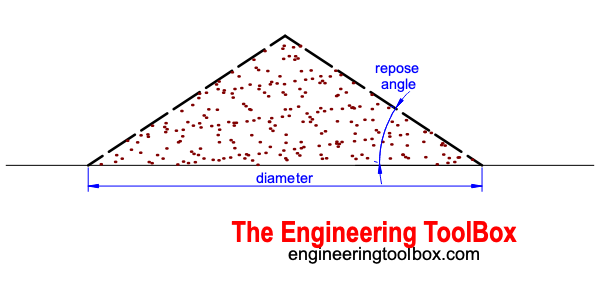
| Angle of Surcharge (degrees) | Angle of Repose (degrees) | Typical Products |
|---|---|---|
| 5 | 0 - 19 | Uniform sized |
| 10 | 20 - 29 | Rounded dry medium weight |
| 20 | 30 - 34 | Granular and lumpy (like coal or Clay) |
| 25 | 35 - 39 | Larger lumps (like coal, stone, ores) |
| 30 | 40 - 45 | Irregular (like wood chips) |
Typical Conveyor Capacity
The chart below indicates typical conveyor capacity vs. belt speed and belt width.
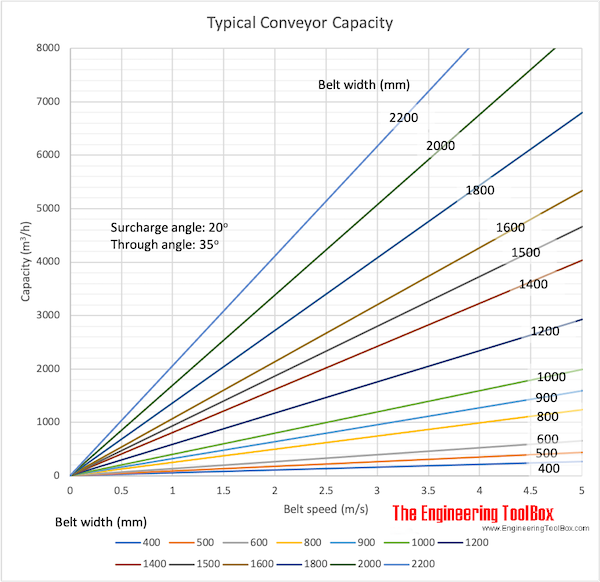
Multiply the volume capacity (m3/h) from the chart with the bulk density (kg/m3) of the product to estimate the weight capacity.



